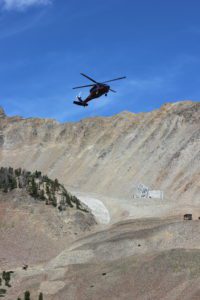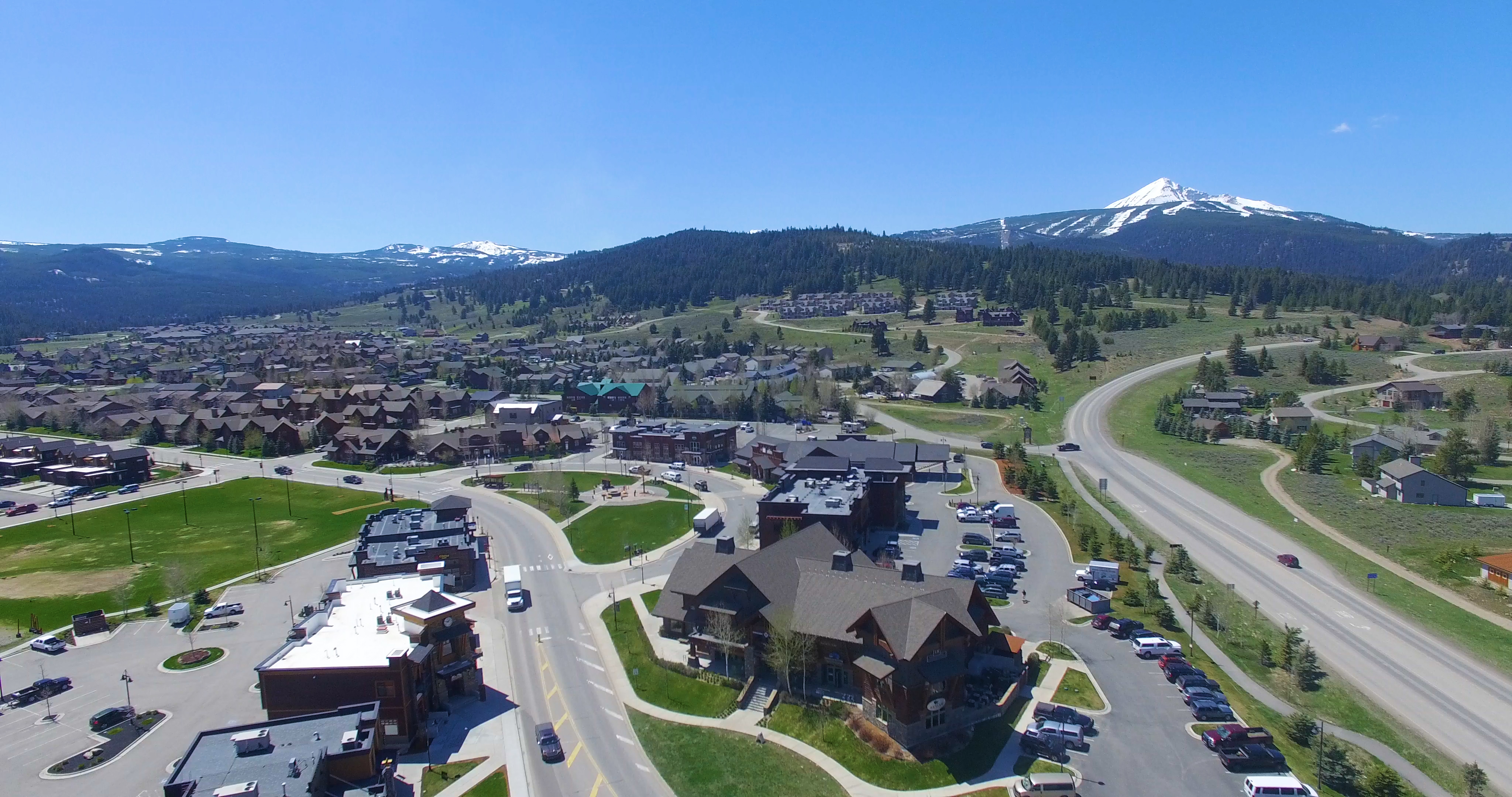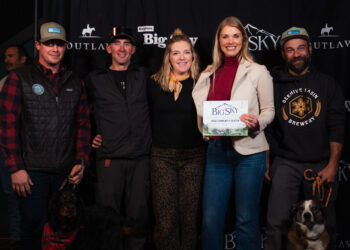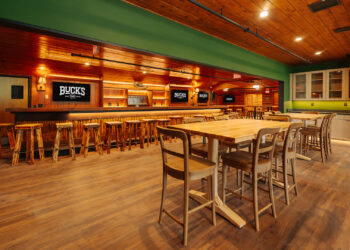Big Sky Resort, tucked among the wild peaks of southwest Montana, began with NBC News anchor Chet Huntley’s dream of “if you build it, they will come” in 1973 and is now attracting visitors and second homeowners in droves. Today, Big Sky epitomizes the modern Wild West as developers are betting big money, to the tune of $1 billion by some accounts, that it will be the world’s next great destination resort community, while its full-time residents hang on for the ride.
In this five-part series, Jackson, Wyoming-based writer Brigid Mander and Explore Big Sky staff interviewed nearly 100 sources to chart the development history of a community that sprouted at the base of a ski area—unusual for Western resorts that typically began as mining or railroad towns where ski infrastructure followed.
This series will take readers through the unorthodox development history of Big Sky, from Huntley’s big idea in the ‘70s; Boyne Resort’s purchase of the resort after Huntley’s untimely death; Tim Blixseth’s acquisition of large swaths of land around Big Sky Resort and his founding of the private Yellowstone Club; financial ruin of three large resorts during the Great Recession and CrossHarbor Capital Partners’ acquisition of them in bankruptcy court; and the explosive development, challenges and opportunities happening here today.
At the core of the community is an iconic, towering peak that’s been drawing snow speculators for more than four decades. – EBS Staff
Part 1: Big ideas germinate and a world-class resort community takes root
By Brigid Mander EBS Contributor
BIG SKY – To get to the official “Biggest Skiing in America,” visitors turn off U.S. Highway 191, onto Montana 64, the only dead-end state highway in the state. It leads straight to Big Sky Resort, the sole reason that 64—also known as Lone Mountain Trail—was paved at all. The ski area is indeed big, to the tune of 5,800 acres of rolling groomers, varied off-piste terrain, as well as challenging long runs and aesthetic couloirs off the tram-accessed and appropriately named Lone Mountain.
On the way, 64 winds through a small valley before the access road begins climbing to the resort—past commercial centers called Meadow Village and Town Center, the latter a collection of newer buildings home to shops, restaurants and offices, with more under construction. Unlike most mountain resort towns, Big Sky is not incorporated, but a “census-designated place,” where approximately 2,500 people claim full-time residence.
Neighborhoods dot the landscape from Highway 191 to the ski resort base area, and spread across the Madison and Gallatin county line. And unlike most mountain communities, where town begets resort, as in Telluride, Revelstoke, or St. Moritz, Big Sky is a case of a ski resort creating a community.
The ski hill boasts the second most acreage in the U.S., behind only the now combined Park City and Canyons resorts in Utah, and the second longest vertical drop after Snowmass, Colorado, with 4,350 feet of descent from Lone Mountain’s summit.
But its tagline, “Biggest Skiing in America,” is more about personal skier space, with just under 500,000 skier visits annually sharing that vast terrain. Compare that to Vail, Colorado’s 5,200 acres and annual skier visits in the neighborhood of 1.7 million people—and legendary lift line bottlenecks.
Off the hill, things in Big Sky are also quiet in the winter months—while the retail and restaurant offerings are improving, the area still lacks a distinctive hub of activity. The switch is flipped during the summer, as recent years have seen the rapidly growing success of the Wednesday farmers market, Thursday night Music in the Mountains concert series, and annual Big Sky PBR in Town Center. Mountain biking has taken off as well, with recent trail expansion at the resort itself and throughout the meadow.
But the SUVs loaded with bikes from Bozeman, or sporting Colorado and Utah license plates, found in Town Center are a stark contrast to when the chairlifts are spinning up at the resort. Foot traffic in “downtown” Big Sky is limited even during a March powder day, when the après scene is concentrated at the ski area or diffused among bars and restaurants spread from Town Center to Meadow Village and Highway 191.
Some Big Sky-area employees prefer the lively, larger community of Bozeman, but many others can’t find or afford housing in Big Sky.
Aside from the resort, one of the most bustling scenes in winter is often the Conoco on the corner of Highway 191 and 64. In the mornings and evenings, lines of construction vehicles swarm to the convenience store and gas station. Groups of three or four men clad in dusty Carhartts or paint-spattered outfits pile out of them, loading up on coffee, or snacks and cold beer for the drive home.
“We used to cater mainly to locals and tourists,” said Renae Schumacher, who has owned the Conoco since 1993. “Each year, there are more and more construction guys, with a 6 to 9 a.m. rush, and also from 4 to 6 p.m. That has definitely increased over the years. But on Saturday and Sunday, the crickets are chirping.”
The non-stop stream of laborers is a testament to the amount of investment being poured into Big Sky, but for many locals and onlookers, questions remain if the solutions to the problems that come with such rapid growth will follow.
A brief development history
Centuries before alpine skiing and chairlifts came to Lone Mountain and its lower flanks, bands of Blackfoot, Crow and Nez Perce, among others, camped and hunted in the area. In the 1800s things changed for the valley, with the permanent farms and ranches of homesteaders. Local historians view the definitive end of that era to be in 1970, when Ed Durnam, a homesteader in Gallatin Canyon since 1914, was killed by modernity’s rude arrival. As Durnam cruised across the highway in his tractor, a semi roared down the road and struck him.
Big Sky Resort opened for business in 1973, but the early days weren’t kind to those who initiated this era. The man whose dream it was to begin with, former NBC News anchor Chet Huntley, lived only a few months past the opening. The original financial backers wanted out after a couple of years, and sold in 1976. The buyer, Michigan-based Boyne Resorts, was saddled with a hastily constructed base area and an inadequate water and sewage system.
Boyne hung on though, and Big Sky changed again 20 years after inception, when timber baron Tim Blixseth acquired land adjacent to the resort, in an event that brought rapid change beyond anyone’s expectations or imagination. The land eventually became three separate developments—the Yellowstone Club, Moonlight Basin and The Club at Spanish Peaks—each of which imploded in high-profile bankruptcies between 2008 and 2013.
Despite the bankruptcies, the opportunities opened by Blixseth were still there, and the three developments surrounding Big Sky Resort were acquired in bankruptcy court by CrossHarbor Capital Partners, a Boston-based private equity fund (which invests money for individuals and groups including university endowments, pension funds, and other firms, and like all private equity is not required to release financial information to the public).
CrossHarbor enthusiastically picked up where the original visionaries left off: The Yellowstone Club is nearly complete and 70 percent sold off to private owners, and seems to have recovered from years of public relations nightmares over damaging legal issues and prominent headlines.

Sales and construction of lots in Moonlight Basin and the re-named Spanish Peaks Mountain Club have picked up again. Investment in the area will easily top $1 billion in the next 10 years, excluding activity inside the Yellowstone Club, estimates Stephen Kircher, president of Boyne Resorts. About $150 to $200 million of that is Boyne’s planned investment in the ski area itself, lodging and employee housing projects, dubbed “Big Sky 2025.”
In light of all this, many in the Big Sky community wonder if it would benefit from becoming an actual town and incorporating, as concerns mount about the pace and volume of development and investment dollars rolling in.
Big Sky was initially run by an HOA called the Big Sky Owners Association, which was constantly hobbled by lawsuits, conflicts of interest and strife among homeowners. But as the community grew, needs expanded. There is still no government, but a collection of seven districts, piloted by board members who are, for the most part, part-time community volunteers. A few positions are elected, but most are appointed and the Gallatin and Madison county commissions oversee their activities.
Montana allows a 3 percent tax rate in resort areas on sales of luxury goods and services. The Big Sky Resort Area District now collects approximately $5 million per year, and the voter-elected tax board allocates the money for municipal needs as well as organizations that help to enrich community life in sports, arts, culture and education initiatives.
While the boards and districts do the work of comparable town governments, and meet most municipal needs, many board members work for, or indirectly depend on the two big employers for their livelihoods: Boyne Resorts or CrossHarbor and its subsidiary Lone Mountain Land Company, which runs Moonlight Basin, Spanish Peaks, and a new development of office space, commercial and residential units in Town Center.
Most people interviewed for this story don’t know how to improve the unusual situation in Big Sky, but there is a sense of unease. If incorporation was the answer, it could simply add a layer of bureaucracy, and more government is anathema to Montana culture. At the moment, no one has much say about the speed, type or scope of development that is currently happening—except the developers.
“When Huntley had this ski hill dream, it didn’t seem like that big of a deal,” said Tim Skop, the county planner tasked with the Gallatin side of Big Sky for the past 11 years. “Now, you have developers looking to assert authority on issues that would normally be tackled by [locally elected government],” he added. “I don’t agree with some that they run the place, but they lead the discussion on these issues.”
Discovering what locals believe is best for the public interest is difficult given that most Big Sky residents and workers don’t want to speak openly. “People are sensitive to being on the record [in Big Sky],” Skop noted. “People don’t want their name by the finger pointing out a big mess.”
“Say the wrong thing to the wrong person and you might find work harder to come by,” said Opie Jahn, former owner of Big Sky’s Caliber Coffee shop.
But regardless of company town politics, the area has a magnetic attraction for its full-time residents. Although it still experiences seasonal workforce swings common to tourist destinations, a collection of small business owners, nonprofit heads and other professionals are committed to making Big Sky their long-term home, despite the difficulties that accompany living in a small resort community.
Erik Morrison has been living and working in Big Sky since 2002, after moving from New England to Bozeman in 1998 to attend Montana State University. He’s an avid snowboarder and the owner of local business Love Street Media.
“Growing up my family moved around a lot. I never really felt a strong sense of home or community,” Morrison said. “That all changed for me when I moved here. … From the power and sacredness of these mountains, to the deep and lasting friendships forged within them, to the opportunities to pursue my passions and grow my career—the community here welcomed me in with open arms and supported me every step of the way.”
“I think Lone Peak is the best skiing and snowboarding in the lower 48,” said Brian Hurlbut, executive director of the Arts Council of Big Sky and a 16-year resident. “Big Sky is so beautiful, and there is a nice little community here, so much year-round recreation, it all drove me to want to live here. It’s a great place for my wife and I to raise our two kids.”
Reporting was contributed by EBS Managing Editor Tyler Allen.
Read the second installment in this series “Chet Huntley’s dream is nearly extinguished, Boyne reignites torch with Lone Peak Tram,” in the July 7 edition of EBS.















